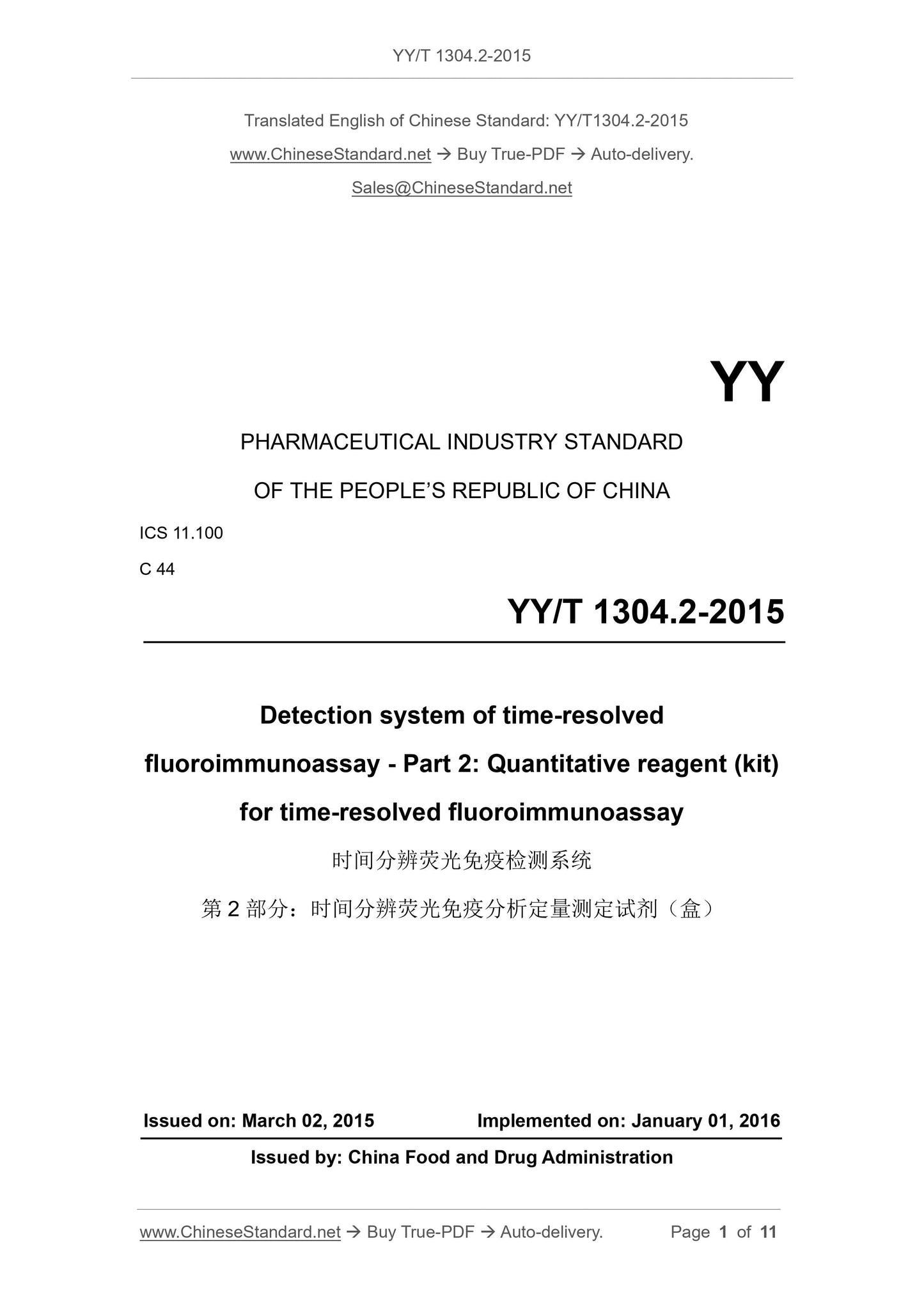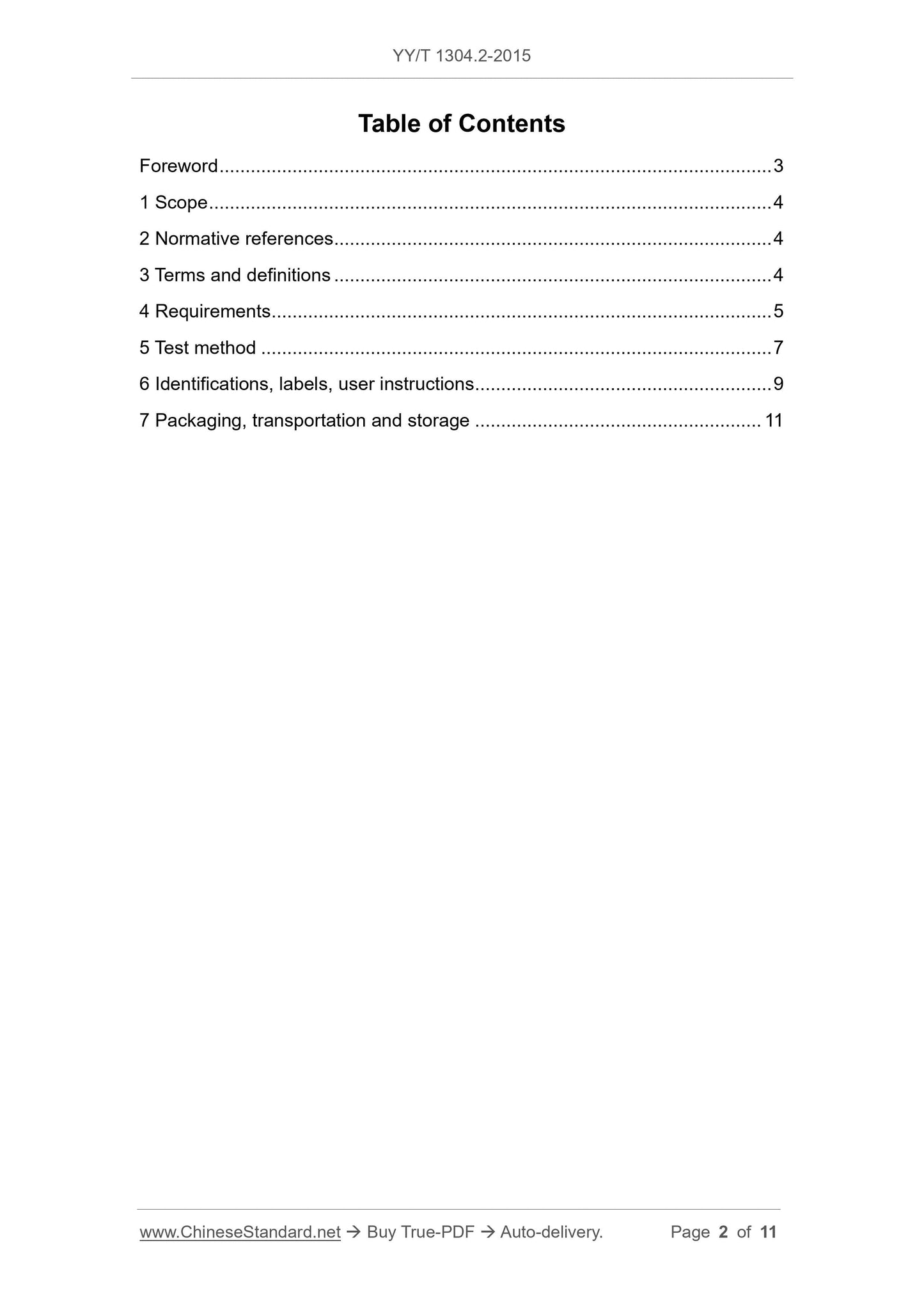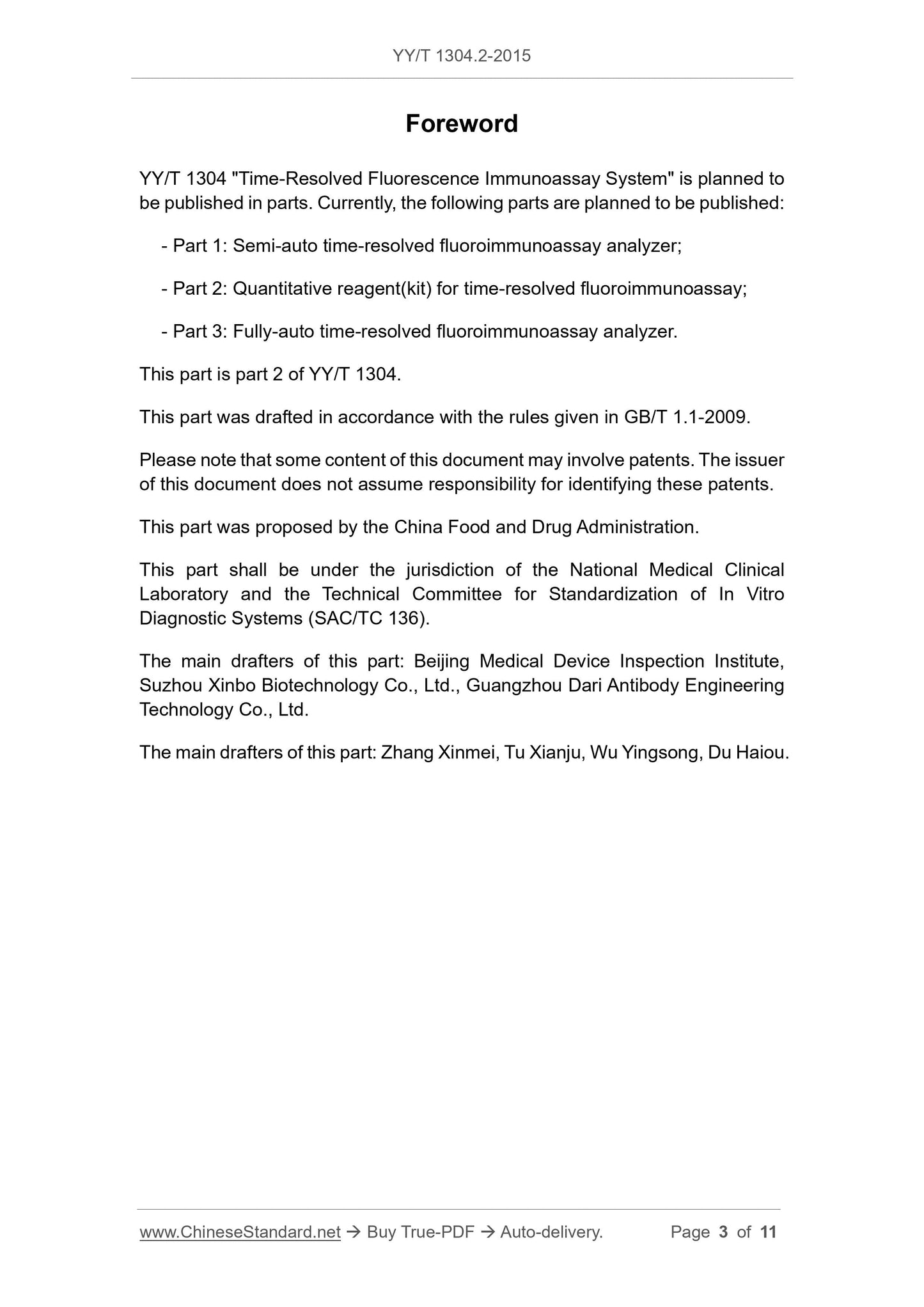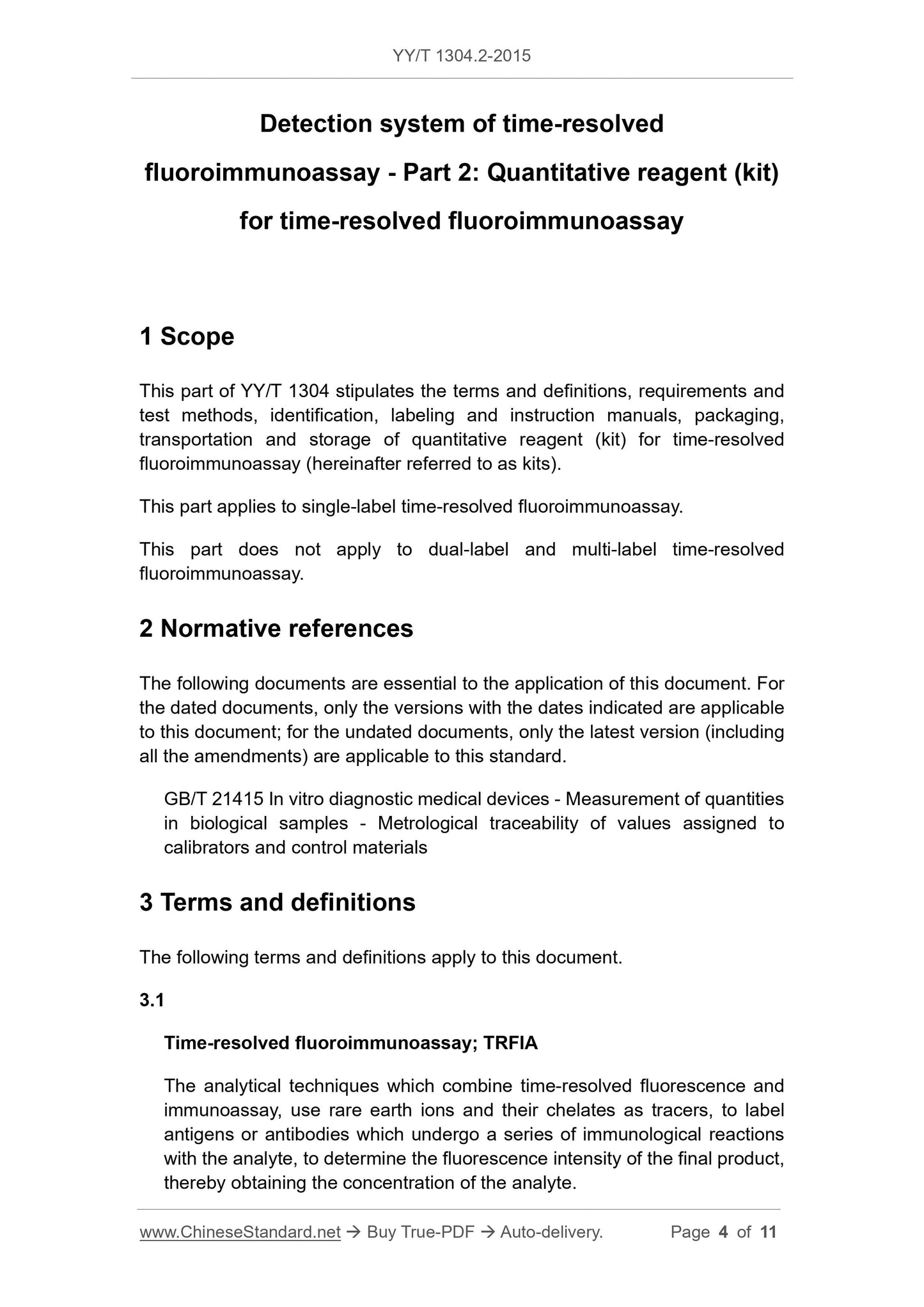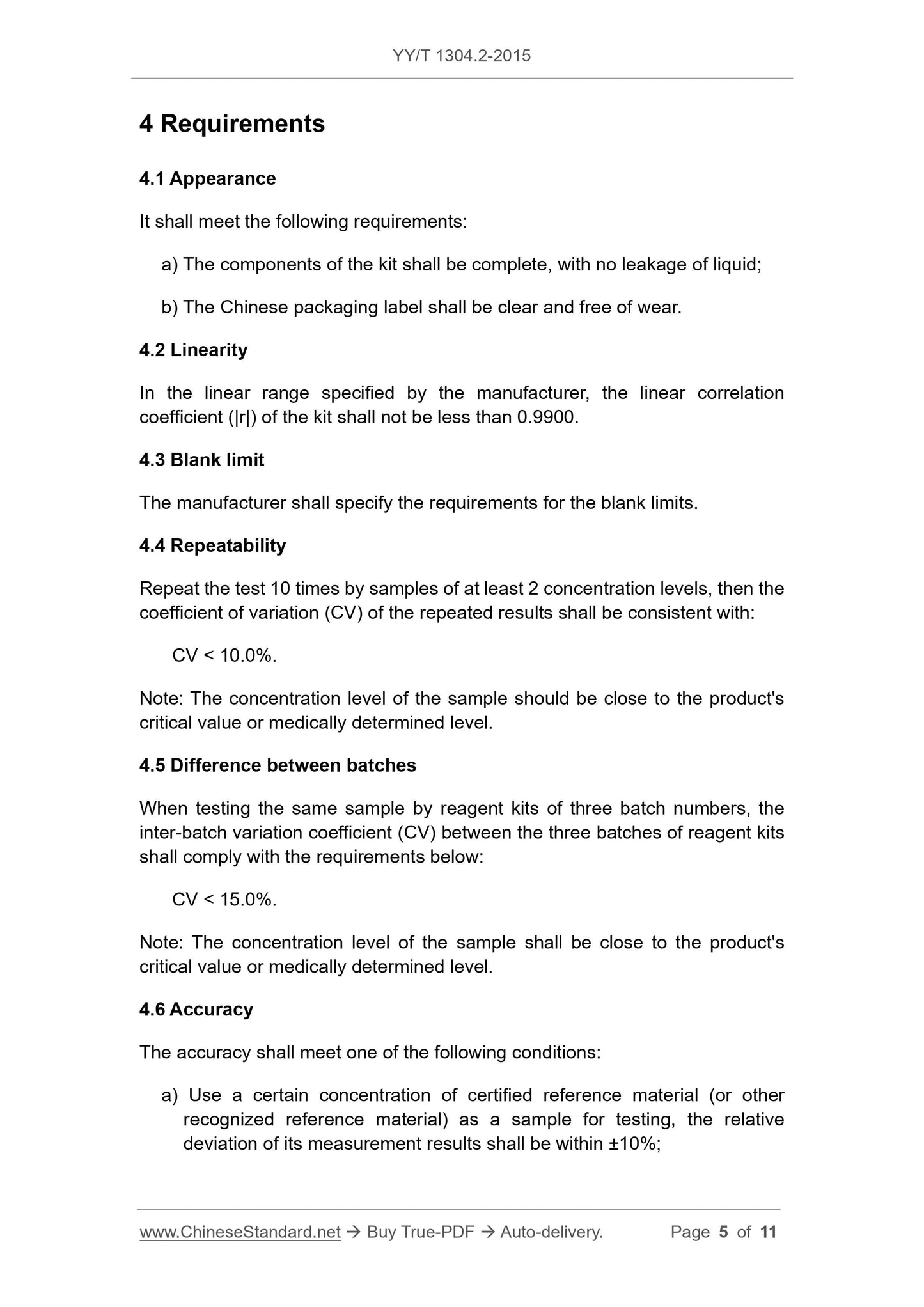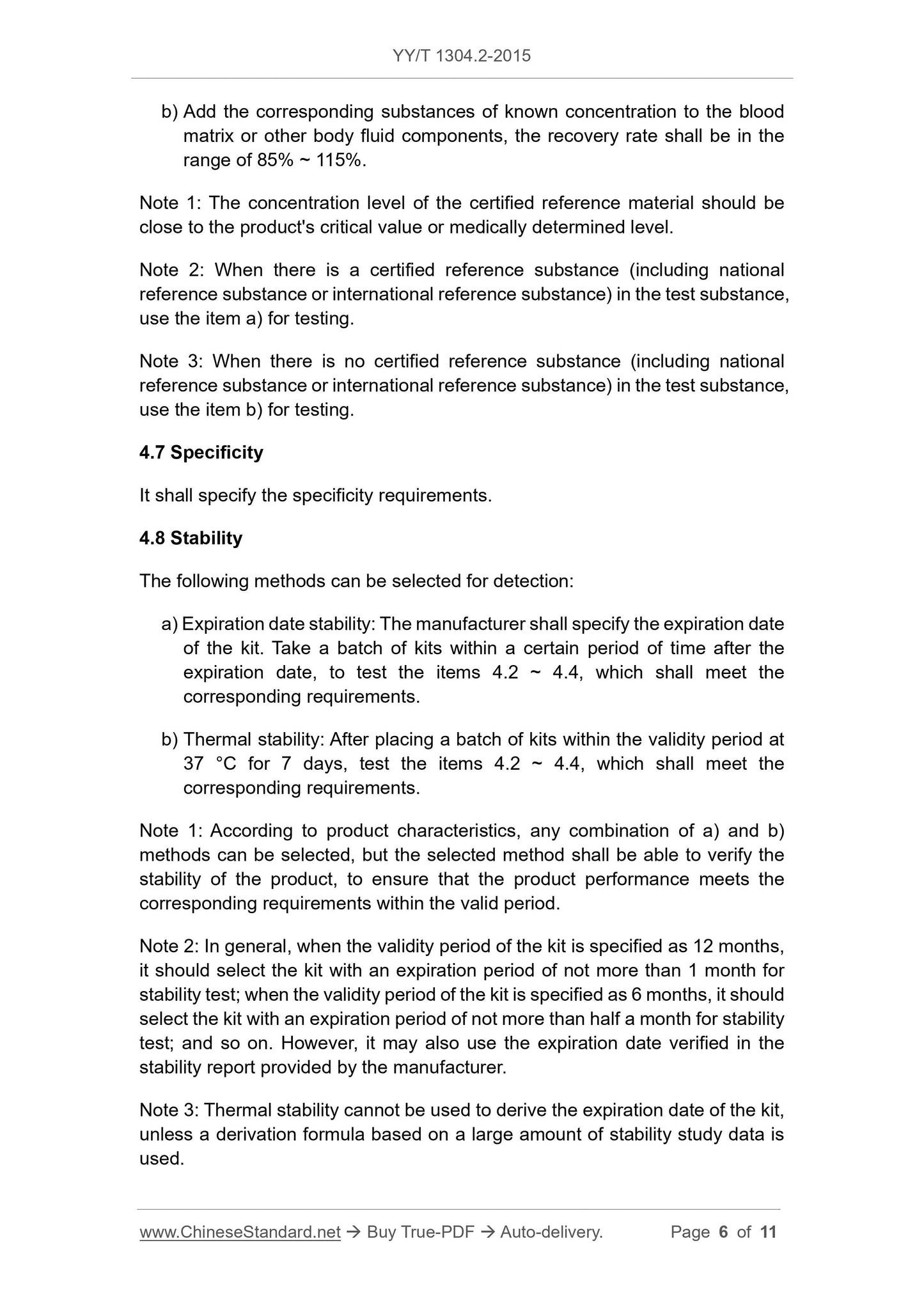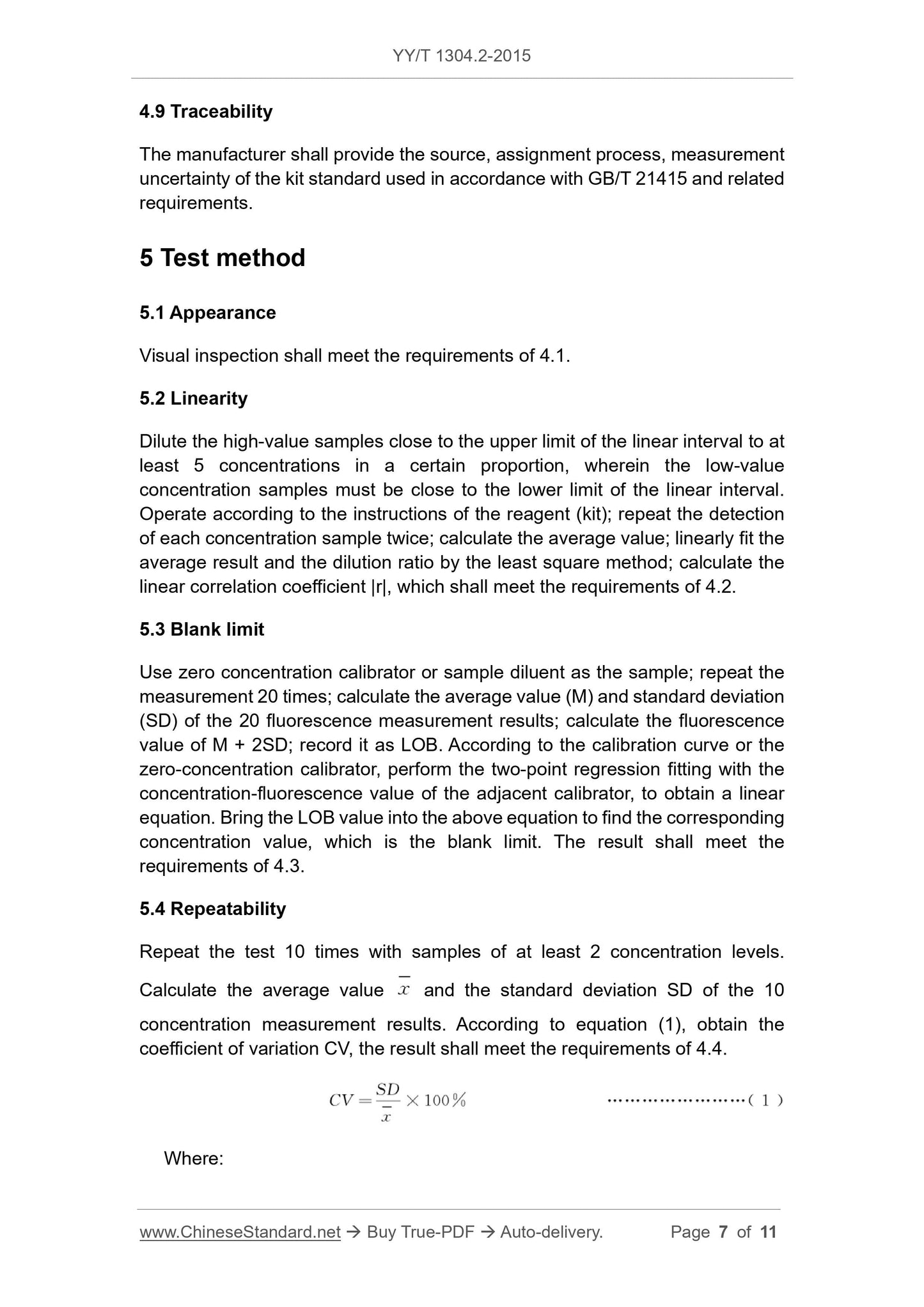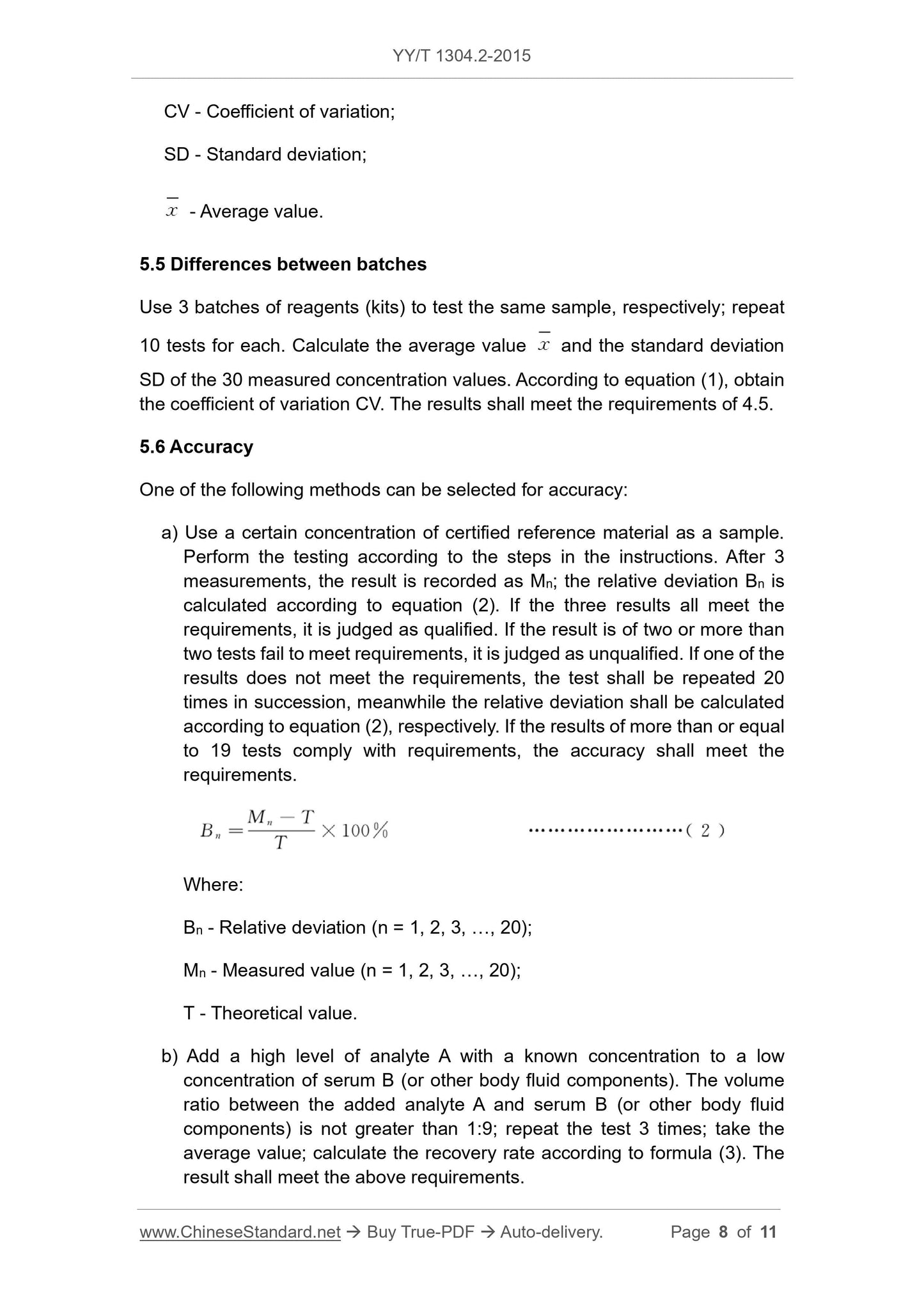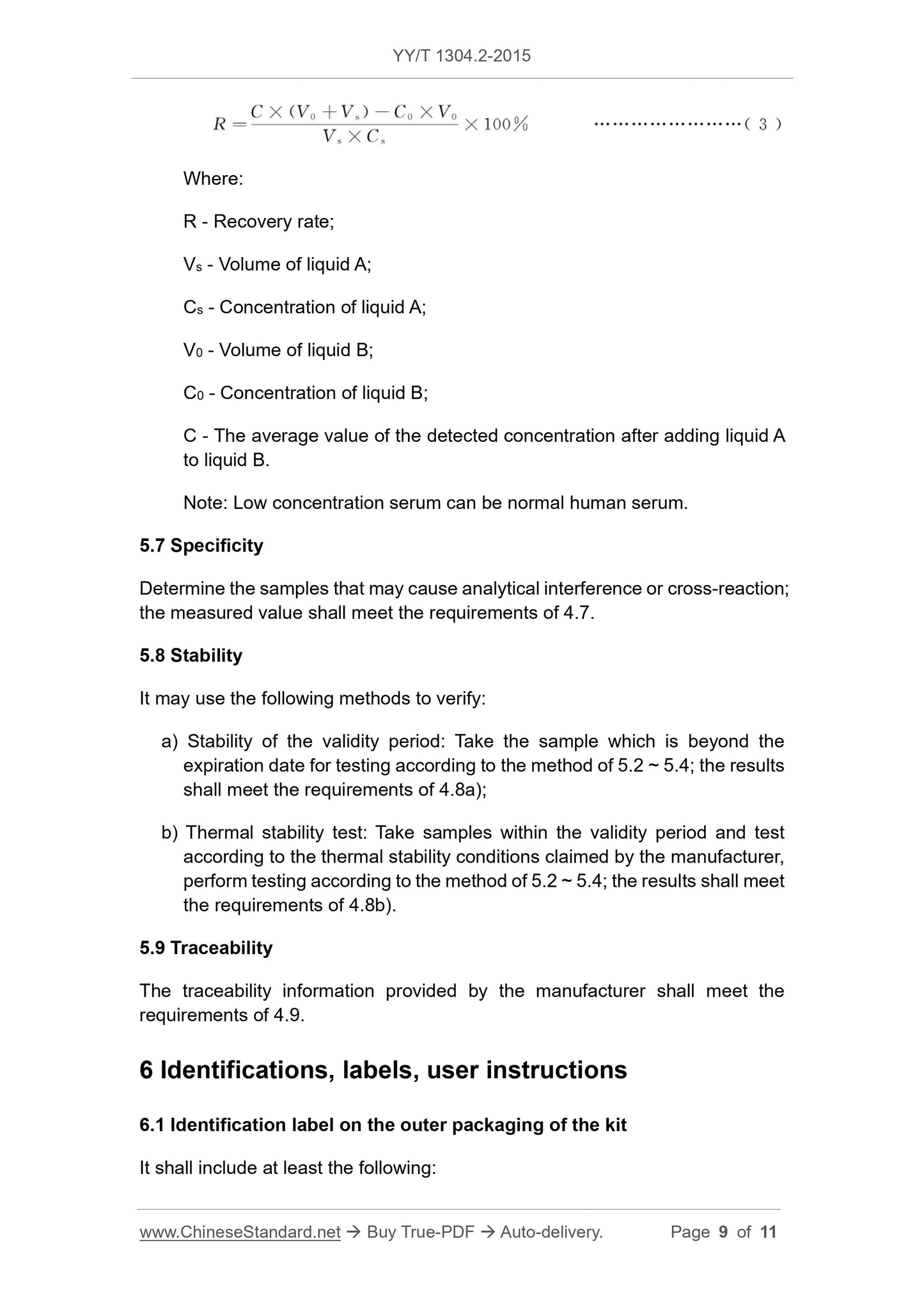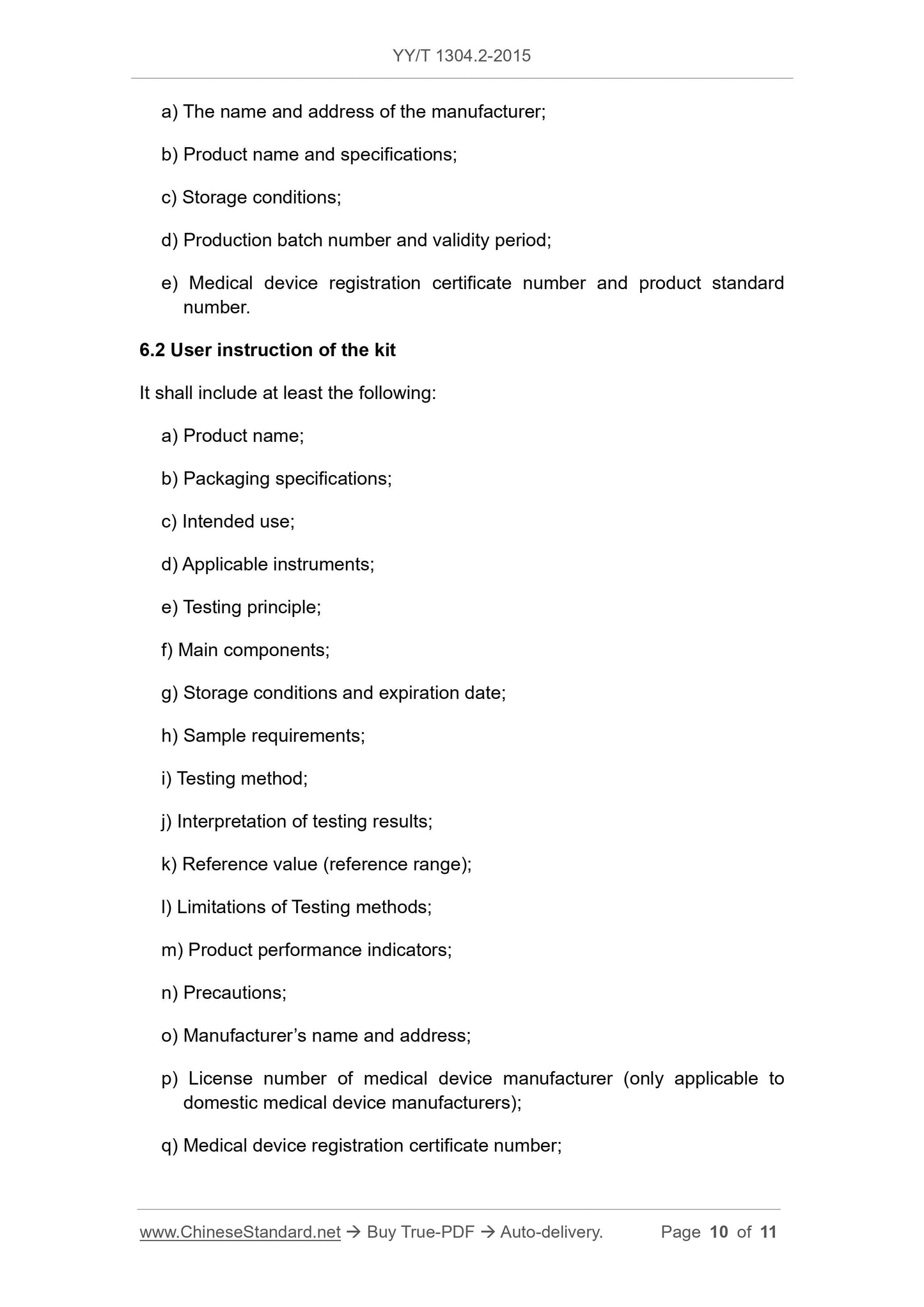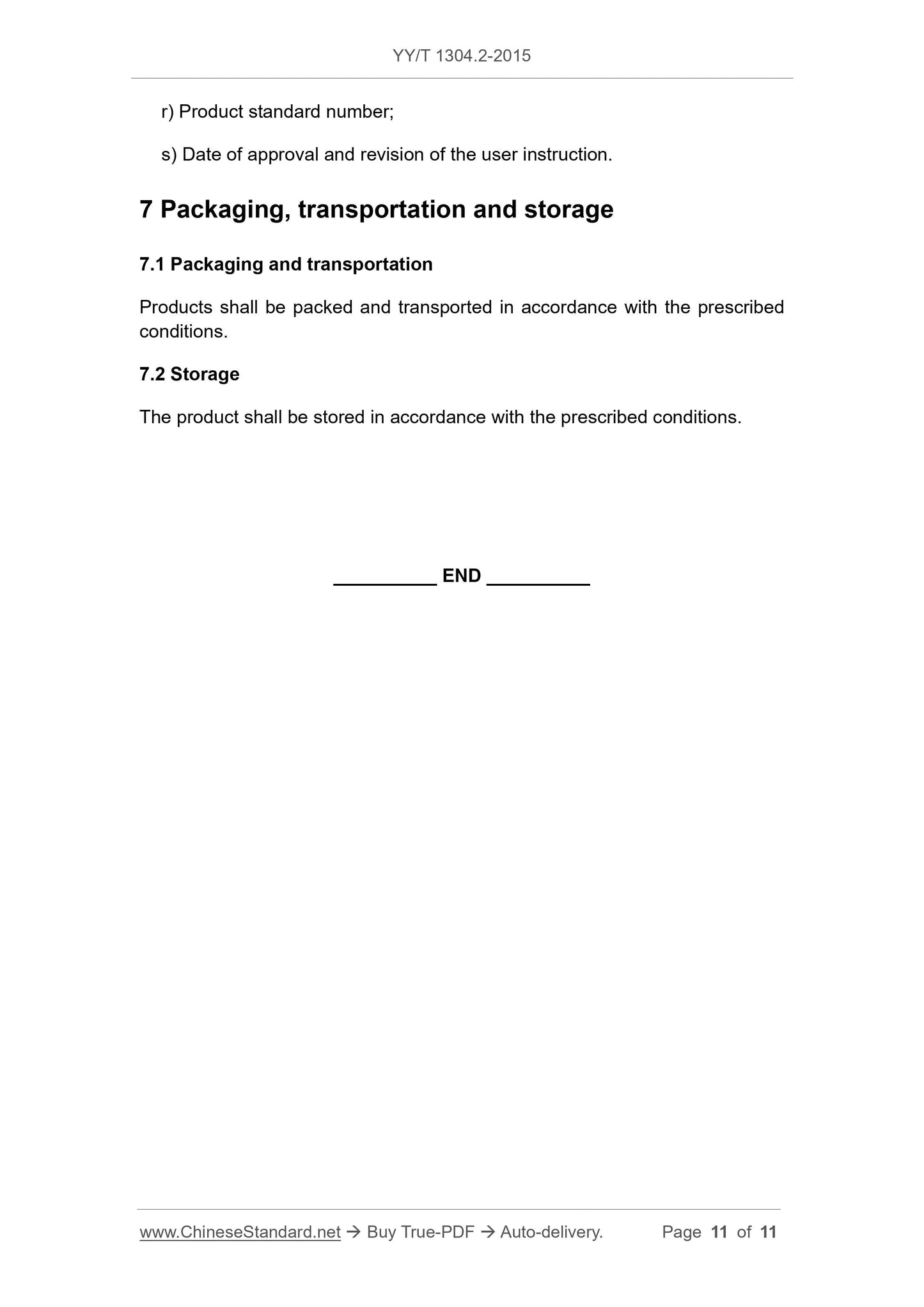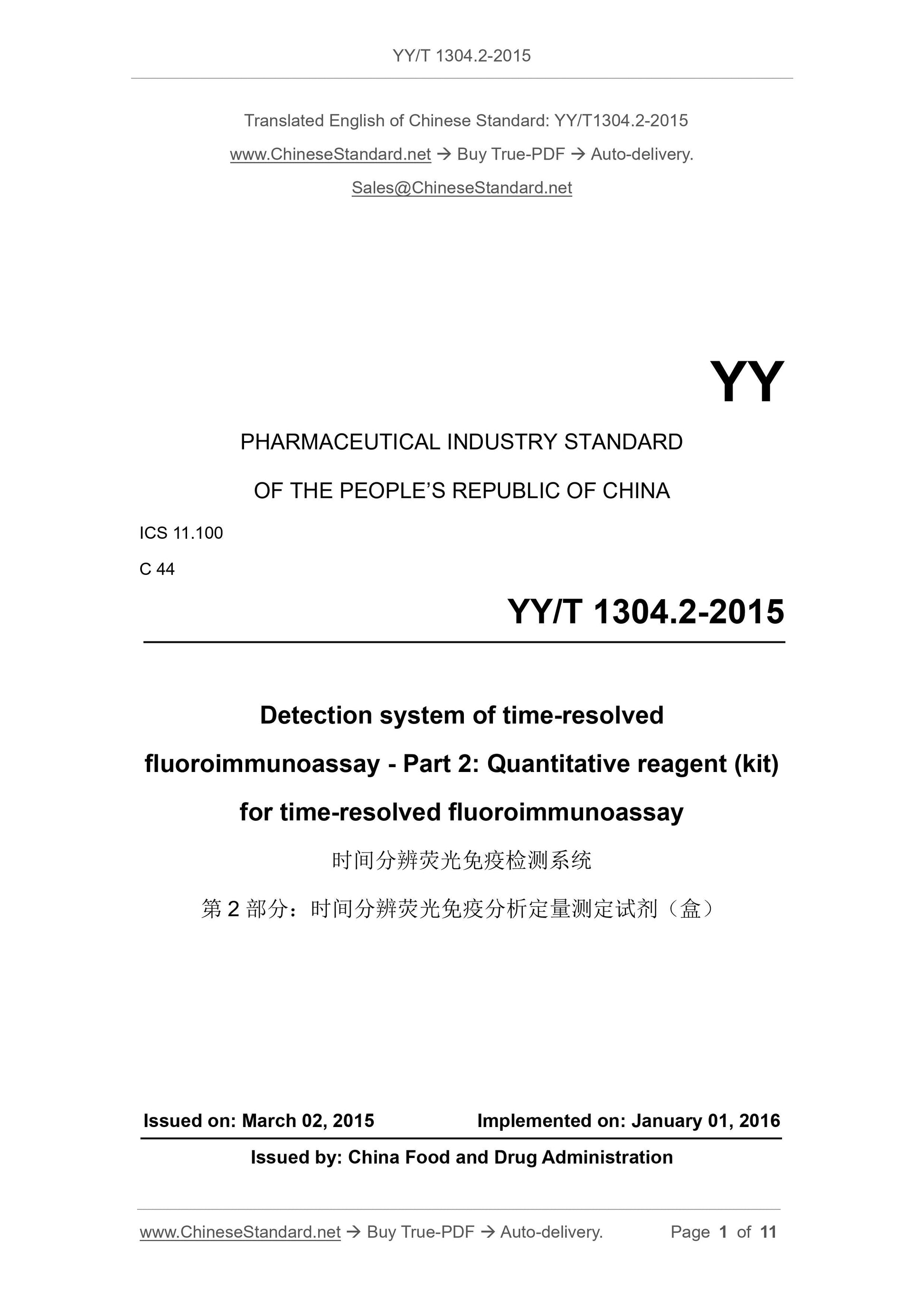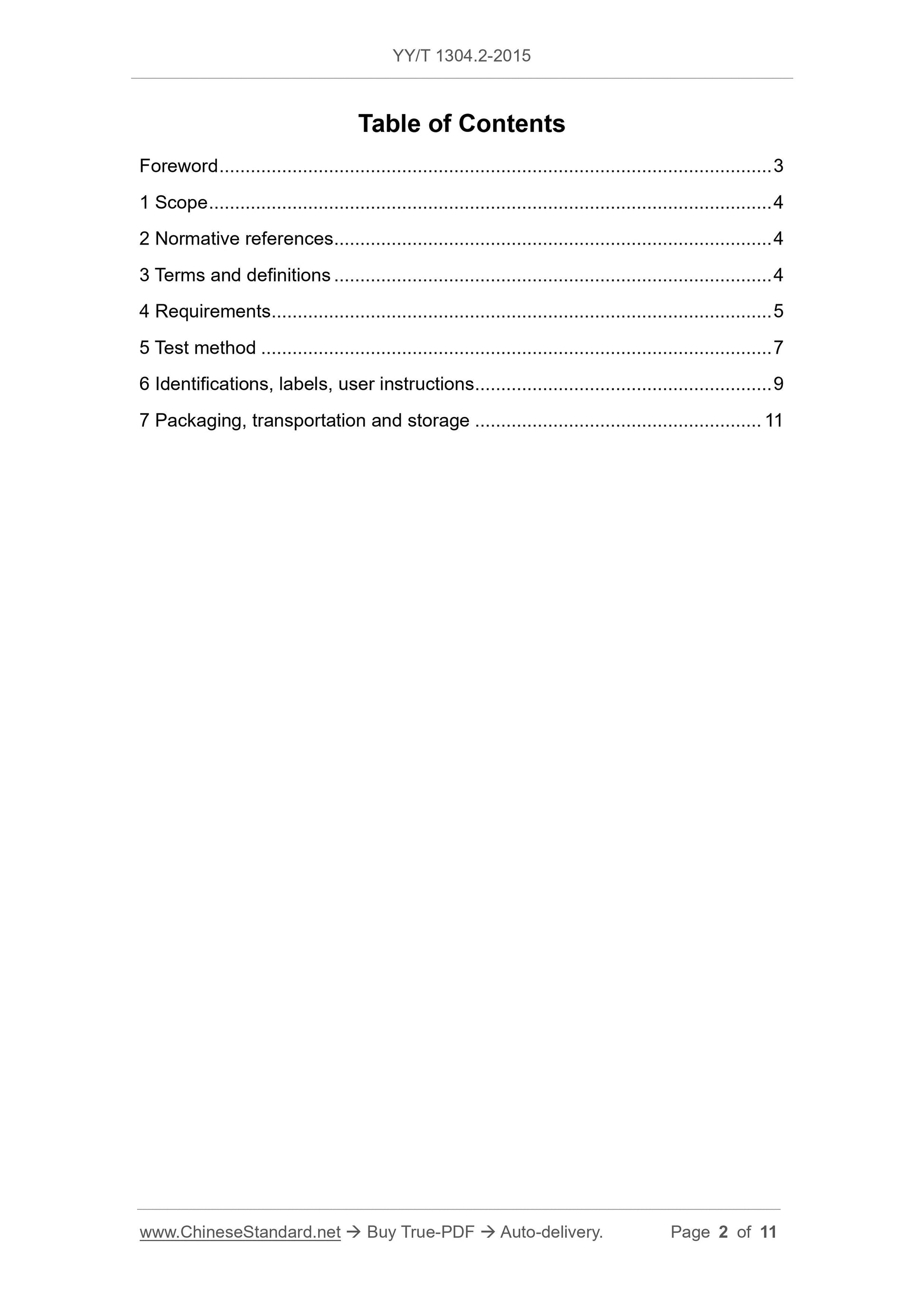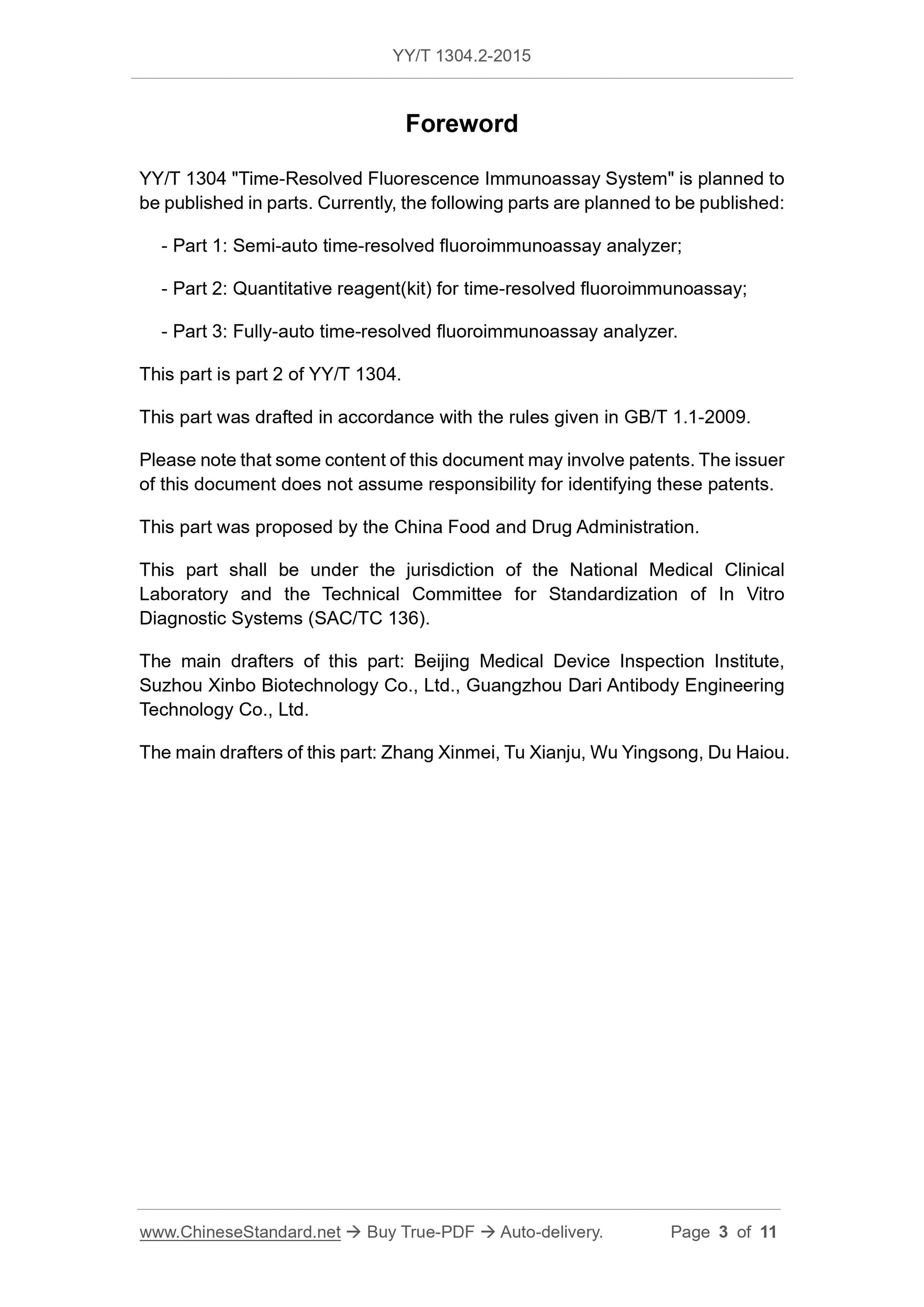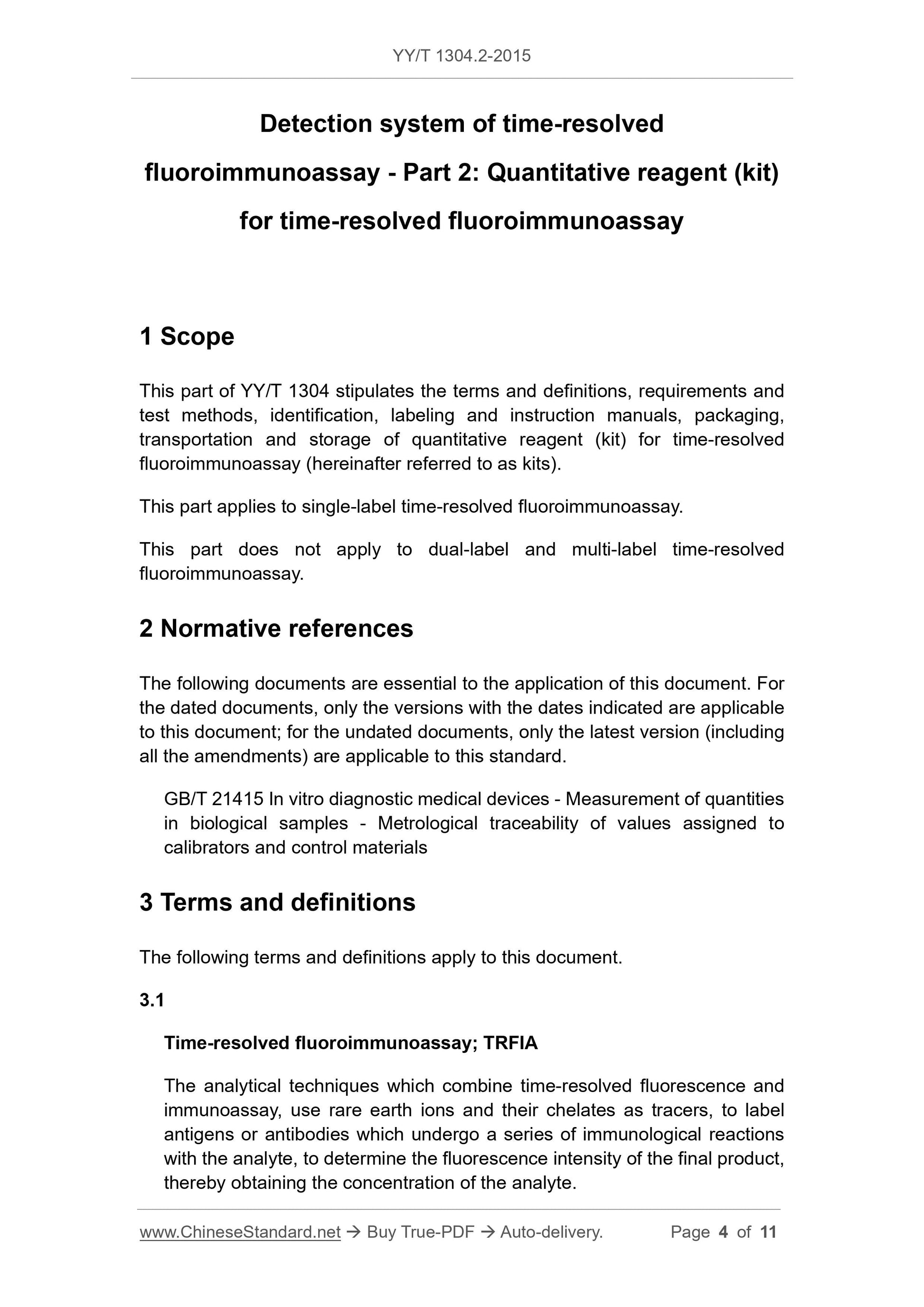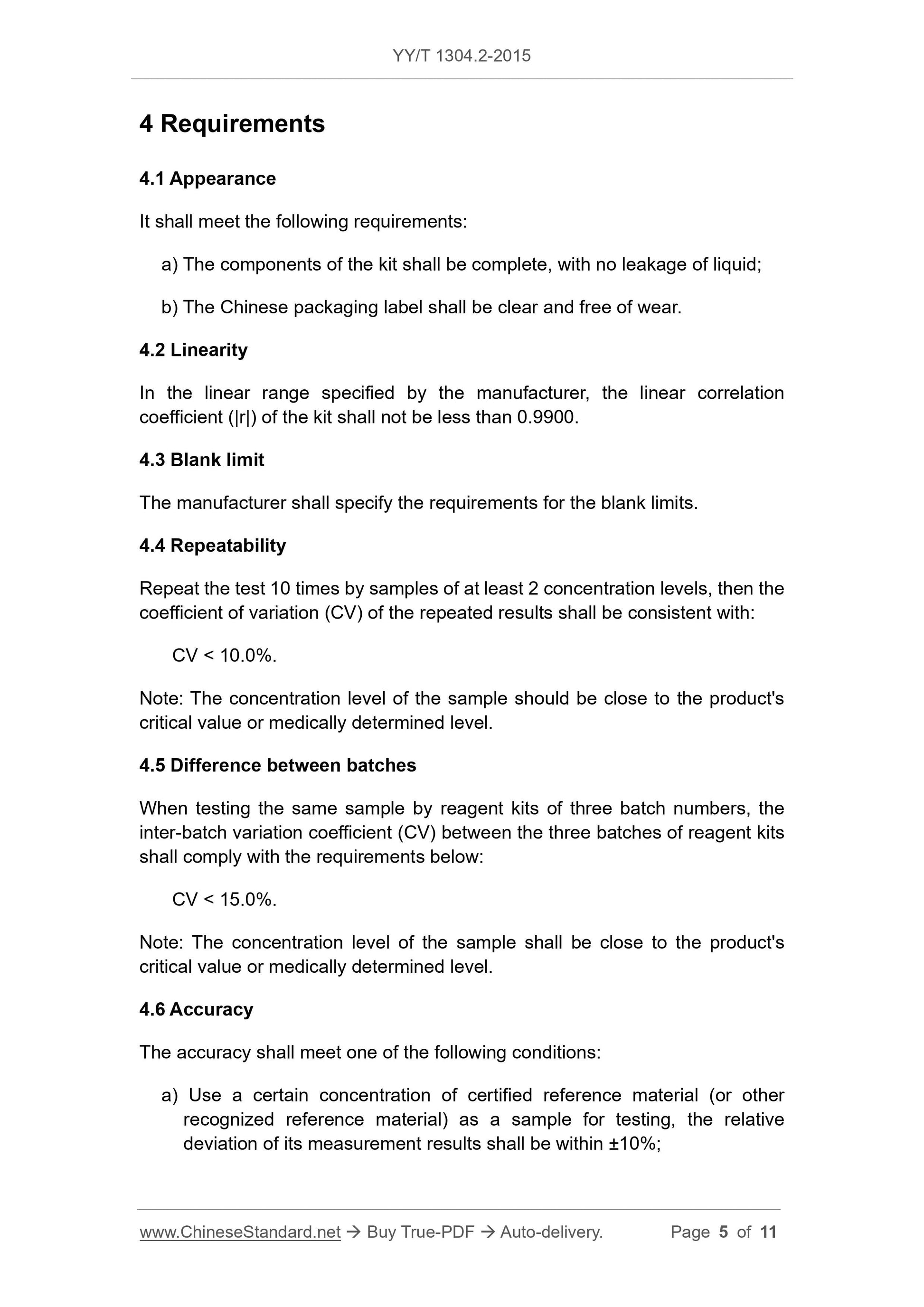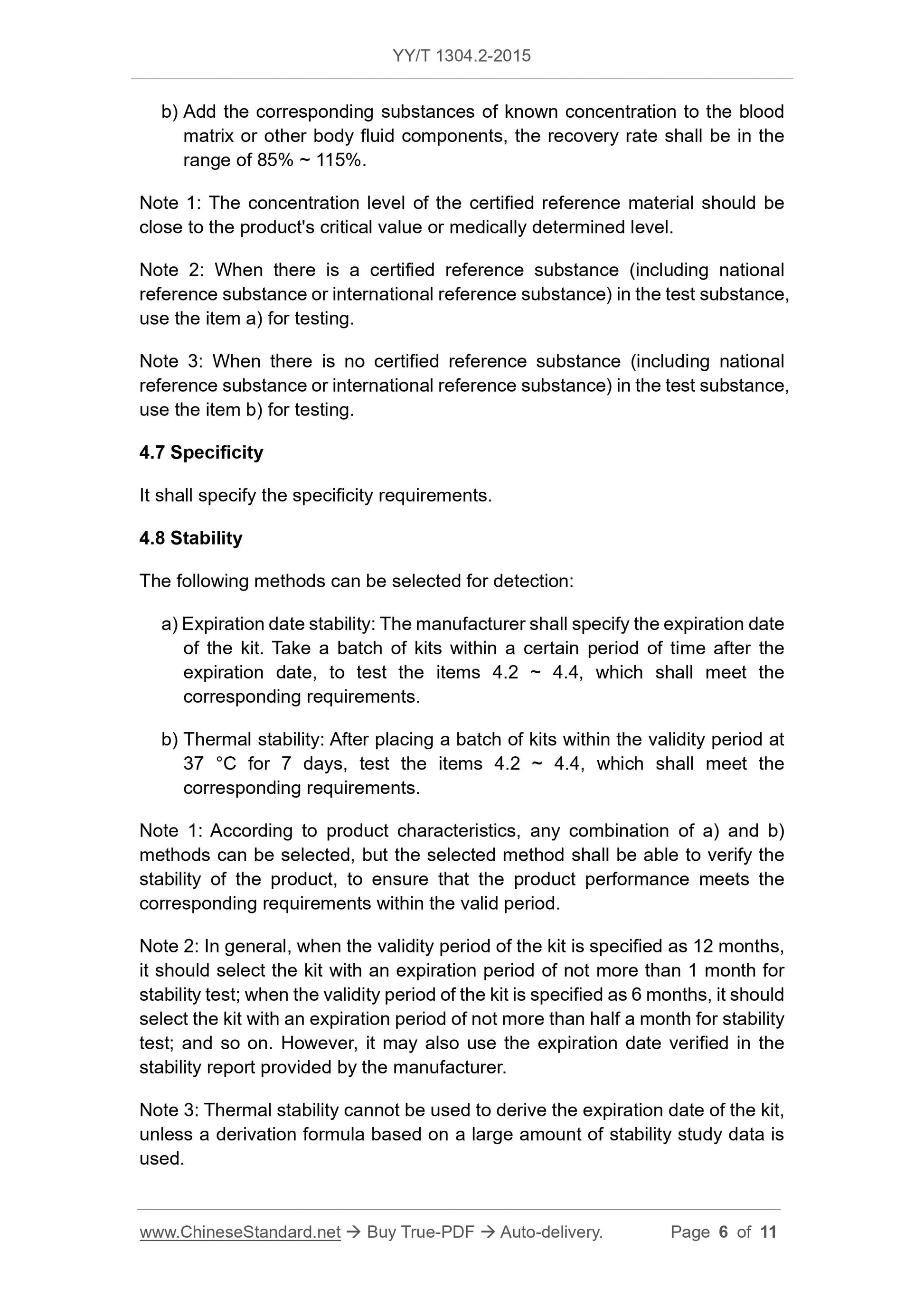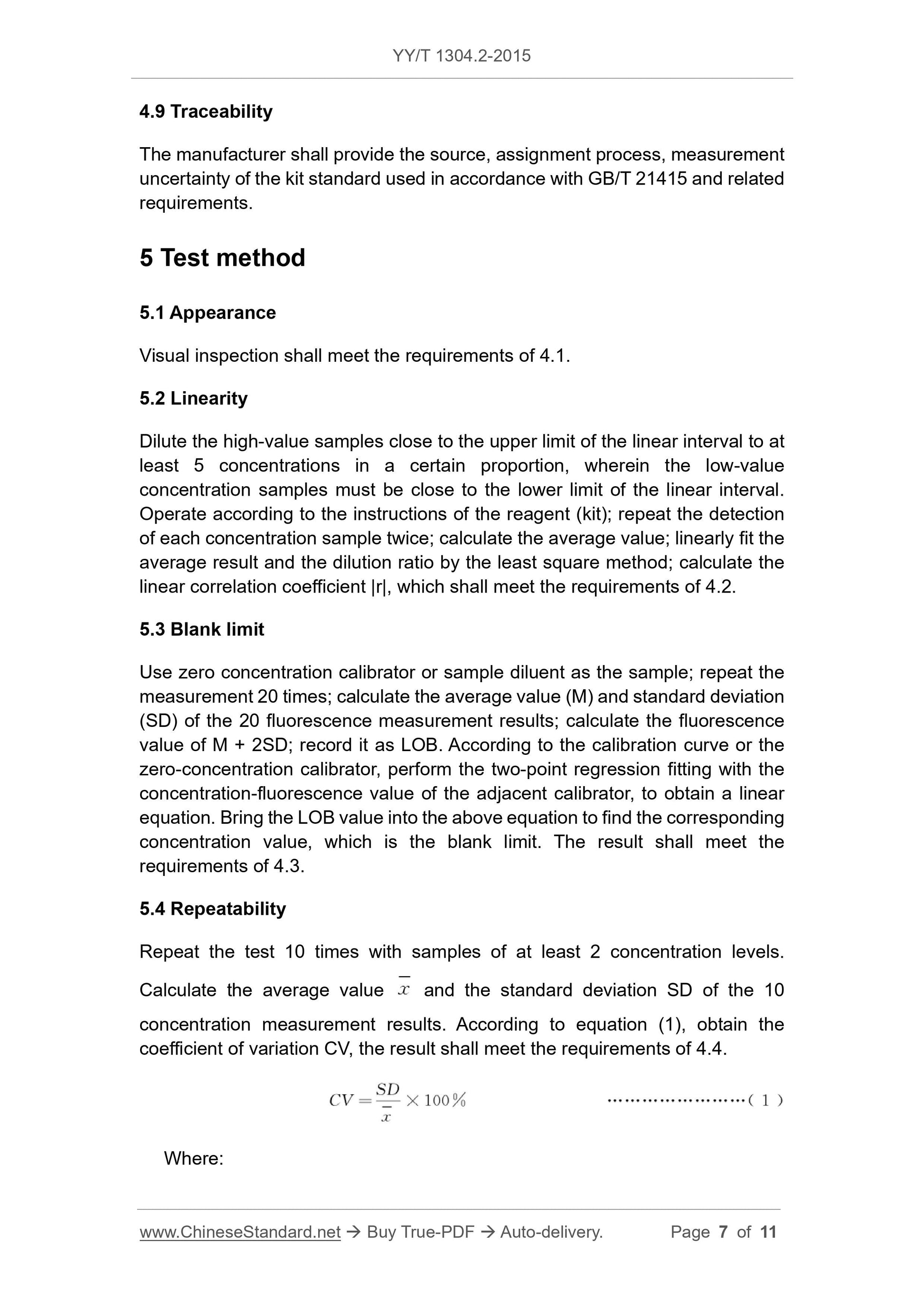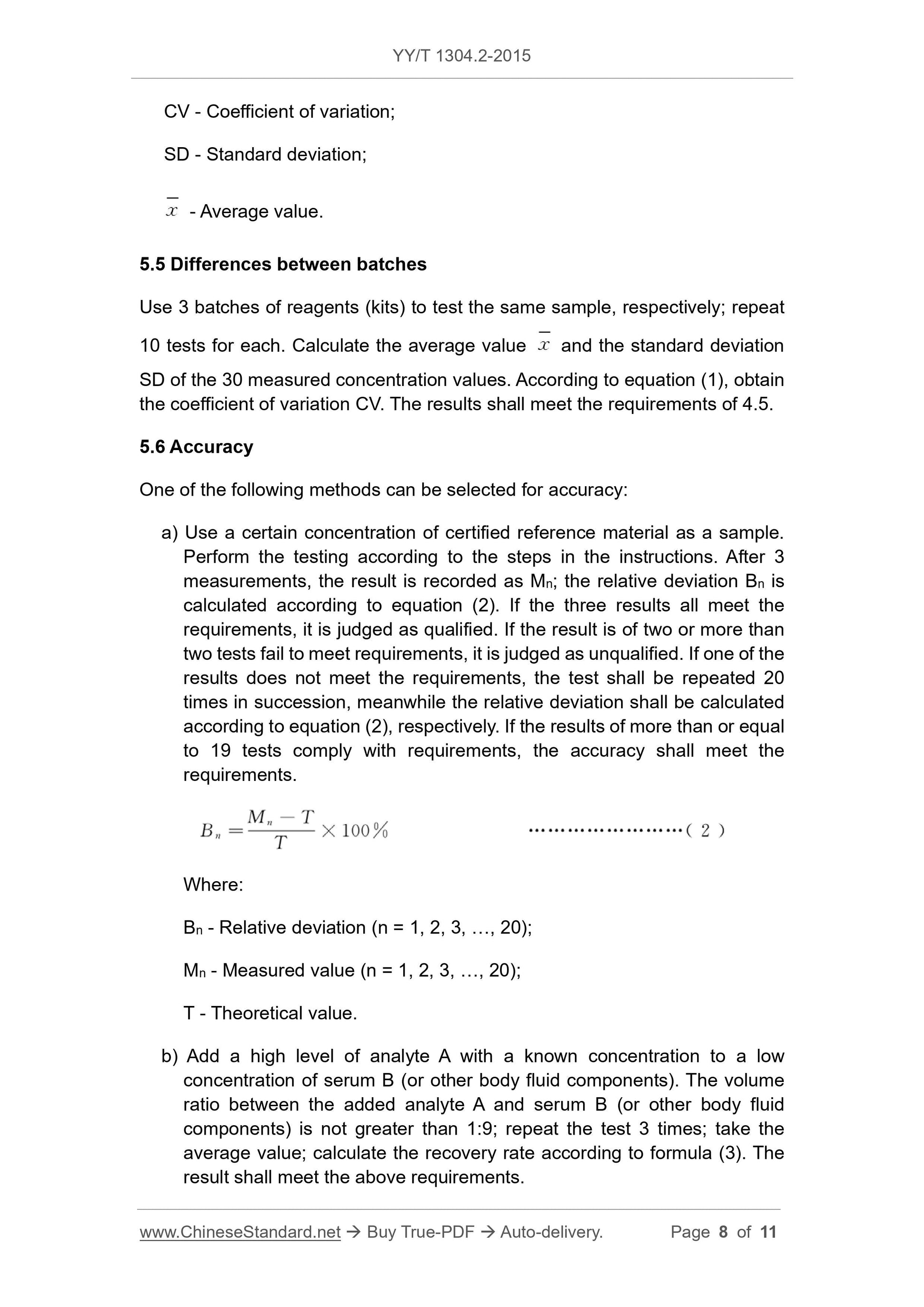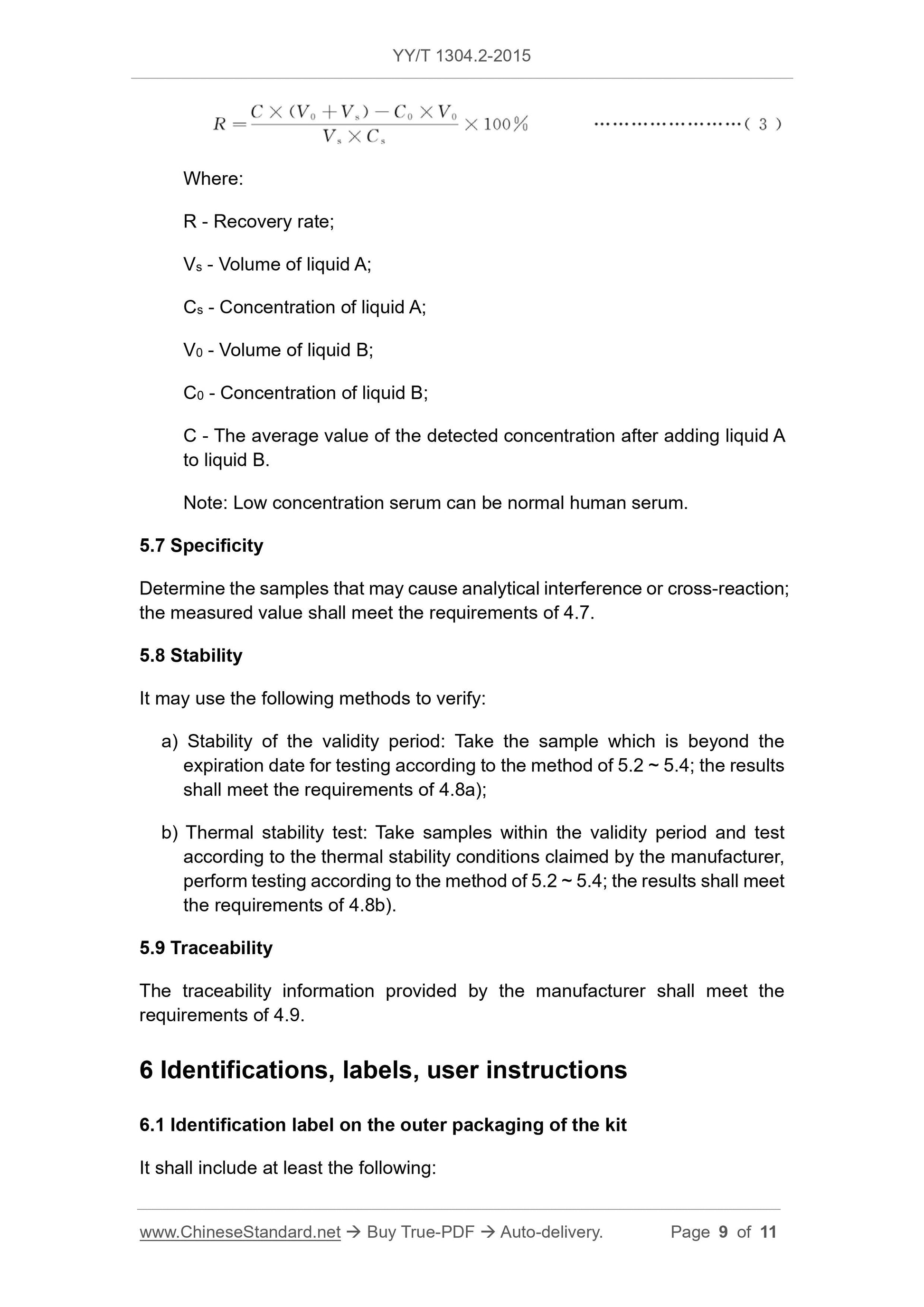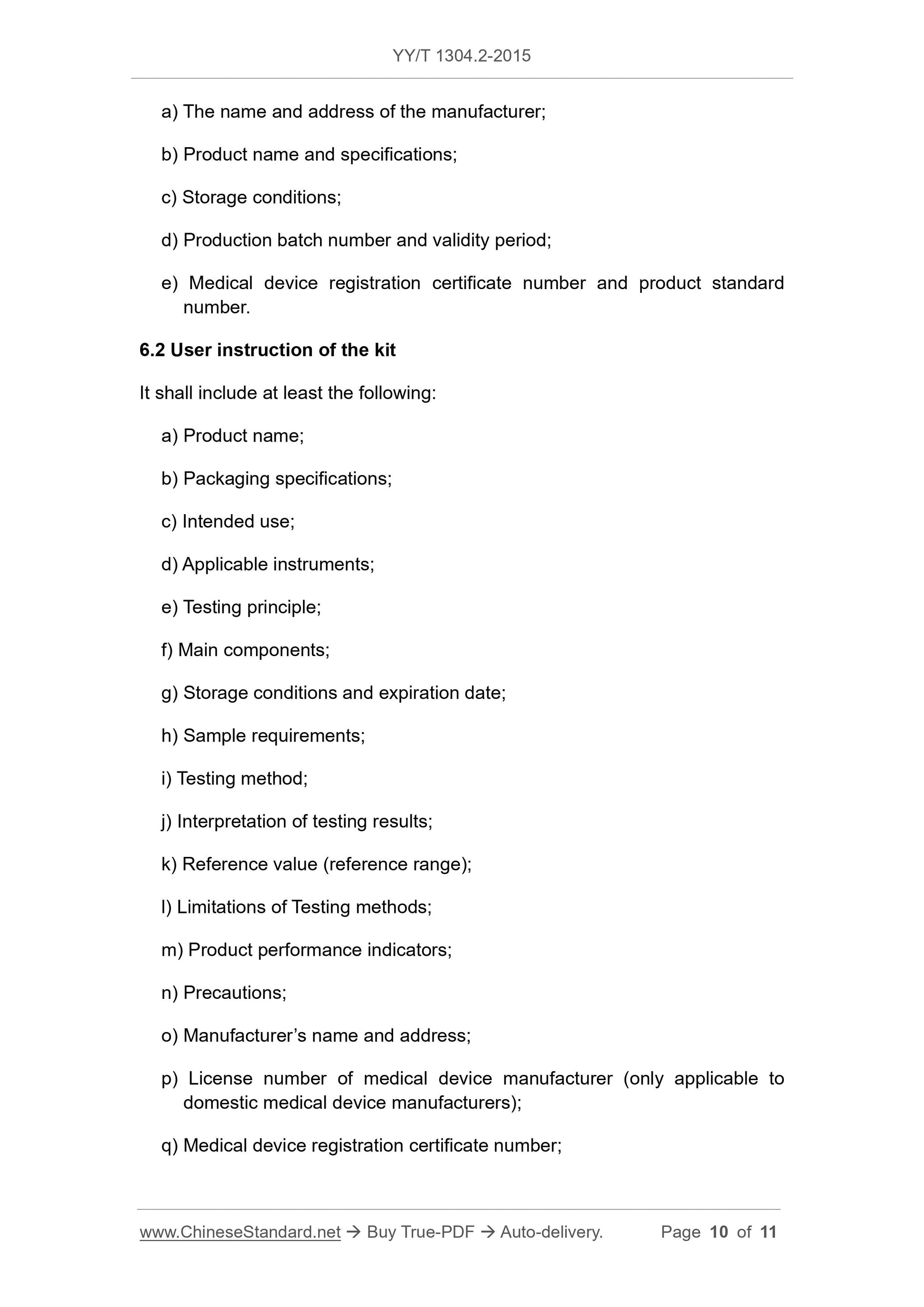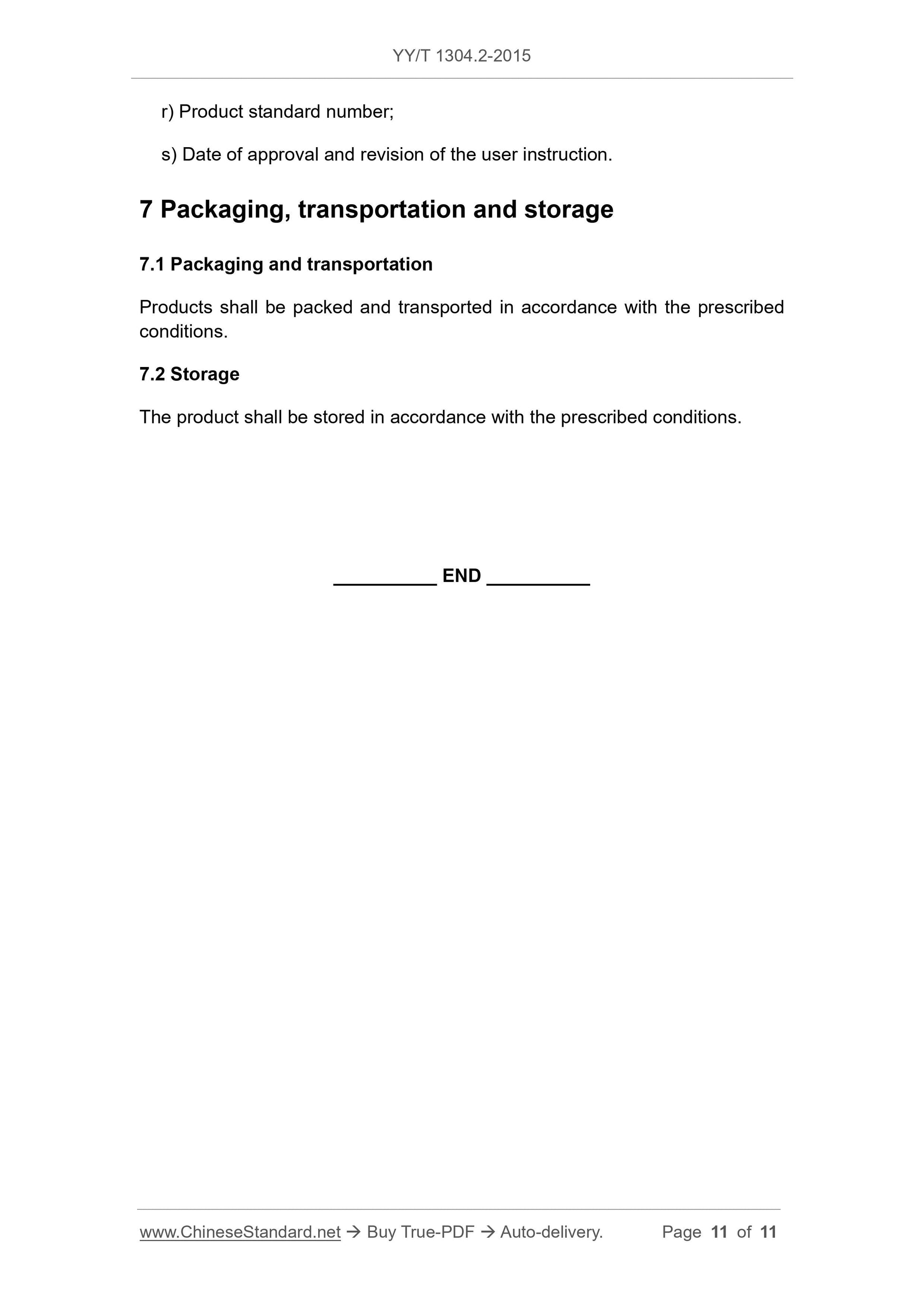1
/
の
11
PayPal, credit cards. Download editable-PDF & invoice in 1 second!
YY/T 1304.2-2015 English PDF (YYT1304.2-2015)
YY/T 1304.2-2015 English PDF (YYT1304.2-2015)
通常価格
$140.00 USD
通常価格
セール価格
$140.00 USD
単価
/
あたり
配送料はチェックアウト時に計算されます。
受取状況を読み込めませんでした
Delivery: 3 seconds. Download true-PDF + Invoice.
Get QUOTATION in 1-minute: Click YY/T 1304.2-2015
Historical versions: YY/T 1304.2-2015
Preview True-PDF (Reload/Scroll if blank)
YY/T 1304.2-2015: Detection system of time-resolved fluoroimmunoassay. Part 2: Quantitative reagent (kit) for time-resolved fluoroimmunoassay
YY/T 1304.2-2015
YY
PHARMACEUTICAL INDUSTRY STANDARD
OF THE PEOPLE’S REPUBLIC OF CHINA
ICS 11.100
C 44
Detection system of time-resolved
fluoroimmunoassay - Part 2: Quantitative reagent (kit)
for time-resolved fluoroimmunoassay
ISSUED ON: MARCH 02, 2015
IMPLEMENTED ON: JANUARY 01, 2016
Issued by: China Food and Drug Administration
Table of Contents
Foreword ... 3
1 Scope ... 4
2 Normative references ... 4
3 Terms and definitions ... 4
4 Requirements ... 5
5 Test method ... 7
6 Identifications, labels, user instructions ... 9
7 Packaging, transportation and storage ... 11
Detection system of time-resolved
fluoroimmunoassay - Part 2: Quantitative reagent (kit)
for time-resolved fluoroimmunoassay
1 Scope
This part of YY/T 1304 stipulates the terms and definitions, requirements and
test methods, identification, labeling and instruction manuals, packaging,
transportation and storage of quantitative reagent (kit) for time-resolved
fluoroimmunoassay (hereinafter referred to as kits).
This part applies to single-label time-resolved fluoroimmunoassay.
This part does not apply to dual-label and multi-label time-resolved
fluoroimmunoassay.
2 Normative references
The following documents are essential to the application of this document. For
the dated documents, only the versions with the dates indicated are applicable
to this document; for the undated documents, only the latest version (including
all the amendments) are applicable to this standard.
GB/T 21415 In vitro diagnostic medical devices - Measurement of quantities
in biological samples - Metrological traceability of values assigned to
calibrators and control materials
3 Terms and definitions
The following terms and definitions apply to this document.
3.1
Time-resolved fluoroimmunoassay; TRFIA
The analytical techniques which combine time-resolved fluorescence and
immunoassay, use rare earth ions and their chelates as tracers, to label
antigens or antibodies which undergo a series of immunological reactions
with the analyte, to determine the fluorescence intensity of the final product,
thereby obtaining the concentration of the analyte.
b) Add the corresponding substances of known concentration to the blood
matrix or other body fluid components, the recovery rate shall be in the
range of 85% ~ 115%.
Note 1: The concentration level of the certified reference material should be
close to the product's critical value or medically determined level.
Note 2: When there is a certified reference substance (including national
reference substance or international reference substance) in the test substance,
use the item a) for testing.
Note 3: When there is no certified reference substance (including national
reference substance or international reference substance) in the test substance,
use the item b) for testing.
4.7 Specificity
It shall specify the specificity requirements.
4.8 Stability
The following methods can be selected for detection:
a) Expiration date stability: The manufacturer shall specify the expiration date
of the kit. Take a batch of kits within a certain period of time after the
expiration date, to test the items 4.2 ~ 4.4, which shall meet the
corresponding requirements.
b) Thermal stability: After placing a batch of kits within the validity period at
37 °C for 7 days, test the items 4.2 ~ 4.4, which shall meet the
corresponding requirements.
Note 1: According to product characteristics, any combination of a) and b)
methods can be selected, but the selected method shall be able to verify the
stability of the product, to ensure that the product performance meets the
corresponding requirements within the valid period.
Note 2: In general, when the validity period of the kit is specified as 12 months,
it should select the kit with an expiration period of not more than 1 month for
stability test; when the validity period of the kit is specified as 6 months, it should
select the kit with an expiration period of not more than half a month for stability
test; and so on. However, it may also use the expiration date verified in the
stability report provided by the manufacturer.
Note 3: Thermal stability cannot be used to derive the expiration date of the kit,
unless a derivation formula based on a large amount of stability study data is
used.
CV - Coefficient of variation;
SD - Standard deviation;
- Average value.
5.5 Differences between batches
Use 3 batches of reagents (kits) to test the same sample, respectively; repeat
10 tests for each. Calculate the average value and the standard deviation
SD of the 30 measured concentration values. According to equation (1), obtain
the coefficient of variation CV. The results shall meet the requirements of 4.5.
5.6 Accuracy
One of the following methods can be selected for accuracy:
a) Use a certain concentration of certified reference material as a sample.
Perform the testing according to the steps in the instructions. After 3
measurements, the result is recorded as Mn; the relative deviation Bn is
calculated according to equation (2). If the three results all meet the
requirements, it is judged as qualified. If the result is of two or more than
two tests fail to meet requirements, it is judged as unqualified. If one of the
results does not meet the requirements, the test shall be repeated 20
times in succession, meanwhile the relative deviation shall be calculated
according to equation (2), respectively. If the results of more than or equal
to 19 tests comply with requirements, the accuracy shall meet the
requirements.
Where:
Bn - Relative deviation (n = 1, 2, 3, …, 20);
Mn - Measured value (n = 1, 2, 3, …, 20);
T - Theoretical value.
b) Add a high level of analyte A with a known concentration to a low
concentration of serum B (or other body fluid components). The volume
ratio between the added analyte A and serum B (or other body fluid
components) is not greater than 1:9; repeat the test 3 times; take the
average value; calculate the recovery rate according to formula (3). The
result shall meet the above requirements.
a) The name and address of the manufacturer;
b) Product name and specifications;
c) Storage conditions;
d) Production batch number and validity period;
e) Medical device registration certificate number and product standard
number.
6.2 User instruction of the kit
It shall include at least the following:
a) Product name;
b) Packaging specifications;
c) Intended use;
d) Applicable instruments;
e) Testing principle;
f) Main components;
g) Storage conditions and expiration date;
h) Sample requirements;
i) Testing method;
j) Interpretation of testing results;
k) Reference value (reference range);
l) Limitations of Testing methods;
m) Product performance indicators;
n) Precautions;
o) Manufacturer’s name and address;
p) License number of medical device manufacturer (only applicable to
domestic medical device manufacturers);
q) Medical device registration certificate number;
Get QUOTATION in 1-minute: Click YY/T 1304.2-2015
Historical versions: YY/T 1304.2-2015
Preview True-PDF (Reload/Scroll if blank)
YY/T 1304.2-2015: Detection system of time-resolved fluoroimmunoassay. Part 2: Quantitative reagent (kit) for time-resolved fluoroimmunoassay
YY/T 1304.2-2015
YY
PHARMACEUTICAL INDUSTRY STANDARD
OF THE PEOPLE’S REPUBLIC OF CHINA
ICS 11.100
C 44
Detection system of time-resolved
fluoroimmunoassay - Part 2: Quantitative reagent (kit)
for time-resolved fluoroimmunoassay
ISSUED ON: MARCH 02, 2015
IMPLEMENTED ON: JANUARY 01, 2016
Issued by: China Food and Drug Administration
Table of Contents
Foreword ... 3
1 Scope ... 4
2 Normative references ... 4
3 Terms and definitions ... 4
4 Requirements ... 5
5 Test method ... 7
6 Identifications, labels, user instructions ... 9
7 Packaging, transportation and storage ... 11
Detection system of time-resolved
fluoroimmunoassay - Part 2: Quantitative reagent (kit)
for time-resolved fluoroimmunoassay
1 Scope
This part of YY/T 1304 stipulates the terms and definitions, requirements and
test methods, identification, labeling and instruction manuals, packaging,
transportation and storage of quantitative reagent (kit) for time-resolved
fluoroimmunoassay (hereinafter referred to as kits).
This part applies to single-label time-resolved fluoroimmunoassay.
This part does not apply to dual-label and multi-label time-resolved
fluoroimmunoassay.
2 Normative references
The following documents are essential to the application of this document. For
the dated documents, only the versions with the dates indicated are applicable
to this document; for the undated documents, only the latest version (including
all the amendments) are applicable to this standard.
GB/T 21415 In vitro diagnostic medical devices - Measurement of quantities
in biological samples - Metrological traceability of values assigned to
calibrators and control materials
3 Terms and definitions
The following terms and definitions apply to this document.
3.1
Time-resolved fluoroimmunoassay; TRFIA
The analytical techniques which combine time-resolved fluorescence and
immunoassay, use rare earth ions and their chelates as tracers, to label
antigens or antibodies which undergo a series of immunological reactions
with the analyte, to determine the fluorescence intensity of the final product,
thereby obtaining the concentration of the analyte.
b) Add the corresponding substances of known concentration to the blood
matrix or other body fluid components, the recovery rate shall be in the
range of 85% ~ 115%.
Note 1: The concentration level of the certified reference material should be
close to the product's critical value or medically determined level.
Note 2: When there is a certified reference substance (including national
reference substance or international reference substance) in the test substance,
use the item a) for testing.
Note 3: When there is no certified reference substance (including national
reference substance or international reference substance) in the test substance,
use the item b) for testing.
4.7 Specificity
It shall specify the specificity requirements.
4.8 Stability
The following methods can be selected for detection:
a) Expiration date stability: The manufacturer shall specify the expiration date
of the kit. Take a batch of kits within a certain period of time after the
expiration date, to test the items 4.2 ~ 4.4, which shall meet the
corresponding requirements.
b) Thermal stability: After placing a batch of kits within the validity period at
37 °C for 7 days, test the items 4.2 ~ 4.4, which shall meet the
corresponding requirements.
Note 1: According to product characteristics, any combination of a) and b)
methods can be selected, but the selected method shall be able to verify the
stability of the product, to ensure that the product performance meets the
corresponding requirements within the valid period.
Note 2: In general, when the validity period of the kit is specified as 12 months,
it should select the kit with an expiration period of not more than 1 month for
stability test; when the validity period of the kit is specified as 6 months, it should
select the kit with an expiration period of not more than half a month for stability
test; and so on. However, it may also use the expiration date verified in the
stability report provided by the manufacturer.
Note 3: Thermal stability cannot be used to derive the expiration date of the kit,
unless a derivation formula based on a large amount of stability study data is
used.
CV - Coefficient of variation;
SD - Standard deviation;
- Average value.
5.5 Differences between batches
Use 3 batches of reagents (kits) to test the same sample, respectively; repeat
10 tests for each. Calculate the average value and the standard deviation
SD of the 30 measured concentration values. According to equation (1), obtain
the coefficient of variation CV. The results shall meet the requirements of 4.5.
5.6 Accuracy
One of the following methods can be selected for accuracy:
a) Use a certain concentration of certified reference material as a sample.
Perform the testing according to the steps in the instructions. After 3
measurements, the result is recorded as Mn; the relative deviation Bn is
calculated according to equation (2). If the three results all meet the
requirements, it is judged as qualified. If the result is of two or more than
two tests fail to meet requirements, it is judged as unqualified. If one of the
results does not meet the requirements, the test shall be repeated 20
times in succession, meanwhile the relative deviation shall be calculated
according to equation (2), respectively. If the results of more than or equal
to 19 tests comply with requirements, the accuracy shall meet the
requirements.
Where:
Bn - Relative deviation (n = 1, 2, 3, …, 20);
Mn - Measured value (n = 1, 2, 3, …, 20);
T - Theoretical value.
b) Add a high level of analyte A with a known concentration to a low
concentration of serum B (or other body fluid components). The volume
ratio between the added analyte A and serum B (or other body fluid
components) is not greater than 1:9; repeat the test 3 times; take the
average value; calculate the recovery rate according to formula (3). The
result shall meet the above requirements.
a) The name and address of the manufacturer;
b) Product name and specifications;
c) Storage conditions;
d) Production batch number and validity period;
e) Medical device registration certificate number and product standard
number.
6.2 User instruction of the kit
It shall include at least the following:
a) Product name;
b) Packaging specifications;
c) Intended use;
d) Applicable instruments;
e) Testing principle;
f) Main components;
g) Storage conditions and expiration date;
h) Sample requirements;
i) Testing method;
j) Interpretation of testing results;
k) Reference value (reference range);
l) Limitations of Testing methods;
m) Product performance indicators;
n) Precautions;
o) Manufacturer’s name and address;
p) License number of medical device manufacturer (only applicable to
domestic medical device manufacturers);
q) Medical device registration certificate number;
Share
